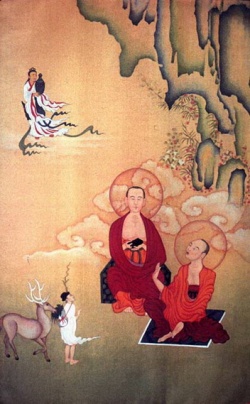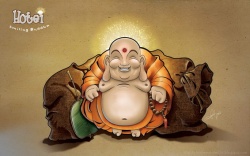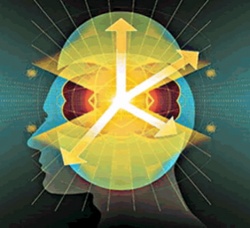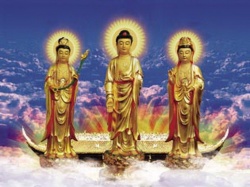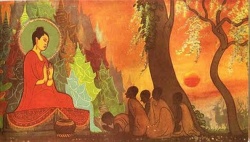Pramana
Pramāṇa (sources of knowledge, Sanskrit प्रमाण or pramāṇas) is an epistemological term in Hindu and Buddhist dialectic, debate and discourse. Pramana (Skt. pramāṇa; Tib. ཚད་མ་, tsema, Wyl. tshad ma) is a Sanskrit term, the primary meaning and most common translation of which is 'valid cognition', meaning the correct knowledge of a particular object. The term is also used to refer to the corpus of Buddhist teachings on epistemology (the science of cognition, i.e. how we know things) and ontology (which investigates the nature of existence), as these two are inextricably linked in Buddhism. The pioneers of these teachings are the Indian masters Dignaga and Dharmakirti. Pramana is taught in all shedras since it is the basis for debate, an important learning tool in traditional monastic universities. In this context the term is sometimes translated as 'Buddhist logic'.
==Definition==
The standard definition of pramana is "a non-deceptive cognition" (Skt. avisaṃvādi-jñāna; Tib. mi bslu ba'i shes pa). There is some debate, particularly amongst Tibetan commentators, as to whether the definition should also specify that a valid cognition realizes something anew (gsar du rtogs pa).[1]
==Subdivisions==
===According to the Instruments of Knowledge===
In the Buddhist tradition, a valid cognition can either be:
- a valid direct perception (Skt. pratyakṣa ; Tib. མངོན་སུམ་, Wyl. mgnon sum tshad ma) or
- a valid inference (Skt. anumāna; Wyl. རྗེས་དཔག་, rjes dpag tshad ma)
This twofold division is said to correspond to the two types of object: particulars, which are known through direct perception and universals, which are understood through inference.
===Conventional and Absolute===
In Mipham Rinpoche's tradition, valid cognition is often divided into conventional valid cognition and absolute valid cognition and these categories are then further subdivided into two:
- Conventional valid cognition (tha snyad tshad ma)
- conventional valid cognition of ordinary limited vision, or valid cognition of ordinary limited vision investigating the conventional level of reality (ma dag tshur mthong tha synad dpyod pa'i tshad ma), and
- conventional valid cognition of pure vision, or valid cognition of pure vision investigating the conventional level of reality (dag pa'i gzigs snang tha snyad dpyod pa'i tshad ma)
- conventional valid cognition of ordinary limited vision, or valid cognition of ordinary limited vision investigating the conventional level of reality (ma dag tshur mthong tha synad dpyod pa'i tshad ma), and
- Valid cognition of the absolute (don dam dpyod byed kyi tshad ma)
==Major Texts==
===Indian===
དམིགས་པ་བརྟག་པ་, dmigs pa brtag pa
ཚད་མ་ཀུན་ལས་བཏུས་པ་, tshad ma kun las btus pa
- Dharmakirti, Seven Treatises on Valid Cognition (Skt. Pramanavartikadisapta-grantha-samgraha; Tib. ཚད་མ་སྡེ་བདུན་, Wyl. tshad ma sde bdun)
===Tibetan===
==Alternative Translations==
- Logic & epistemology
- Prime cognition
- Verifying cognition
==Notes==
- ↑ For more information see Dreyfus (1997), pp. 366-378 passim
Pramāṇavāda and Hetuvidyā (因明) can be glossed in English as Indian and Buddhist epistemology and logic, respectively.
In Hinduism
Different systems of Hindu philosophy accept different categories of pramanas.
Pramāṇa forms one part of a tripuţi (trio) concerning pramā (the correct knowledge of any object arrived at by thorough reasoning, Sanskrit), namely,
Pramātā (< pramātŗ), the subject, the knower
Pramāņa, the means of obtaining the knowledge
Prameya, the object, the knowable
Modern Buddhist schools do not use these three distinct terms particularly, but instead employ the 'three spheres' (Sanskrit: trimaṇḍala; Tibetan: 'khor gsum):
subject
object, and
action.
Vaisheshika
Epistemologically, the Vaiśeṣika school accepts as valid sources of knowledge.
perception (pratyakṣa)
inference (anumāna)
Sankhya, Vishishtadvaita Vedanta, and Dvaita Vedanta
According to the Sankhya school, knowledge is possible through three pramanas:
Pratyakşa — direct sense perception
Anumāna — logical inference
Śabda — Verbal testimony
Nyaya
The Nyāya school accepts four means of obtaining knowledge (pramāṇa), viz., Perception, Inference, Comparison and Word.
Perception, called Pratyakṣa, occupies the foremost position in the Nyaya epistemology. Perception is defined by sense-object contact and is unerring. Perception can be of two types:
Ordinary (Laukika or Sādhārana), of six types, viz., visual-by eyes, olfactory-by nose, auditory-by ears, tactile-by skin, gustatory-by tongue and mental-by mind.
Extraordinary (Alaukika or Asādhārana), of three types, viz., Sāmānyalakṣana (perceiving generality from a particular object), Jñānalakṣana (when one sense organ can also perceive qualities not attributable to it, as when seeing a chilli, one knows that it would be bitter or hot), and Yogaja (when certain human beings, from the power of Yoga, can perceive past, present and future and have supernatural abilities, either complete or some). Also, there are two modes or steps in perception, viz., Nirvikalpa, when one just perceives an object without being able to know its features, and Savikalpa, when one is able to clearly know an object. All laukika and alaukika pratyakshas are savikalpa. There is yet another stage called Pratyabhijñā, when one is able to re-recognise something on the basis of memory.
Inference, called Anumāna, is one of the most important contributions of Nyaya. It can be of two types – inference for oneself (Svārthānumāna, where one does not need any formal procedure, and at the most the last three of their 5 steps), and inference for others (Parāthānumāna, which requires a systematic methodology of 5 steps). Inference can also be classified into 3 types: Pūrvavat (inferring an unperceived effect from a perceived cause), Śeṣavat (inferring an unperceived cause from a perceived effect) and Sāmānyatodṛṣṭa (when inference is not based on causation but on uniformity of co-existence). A detailed analysis of error is also given, explaining when anumāna could be false.
Comparison, which is the rough transplation of Upamāna. It is the knowledge of the relationship between a word and the object denoted by the word. It is produced by the knowledge of resemblance or similarity, given some pre-description of the new object beforehand.
Word, or Śabda are also accepted as a pramāṇa. It can be of two types, Vaidika (Vedic), which are the words of the four sacred Vedas, or can be more broadly interpreted as knowledge from sources acknowledged as authoritative, and Laukika, or words and writings of trustworthy human beings.
Advaita Vedanta and Mimamsa
In Advaita Vedānta, the following pramanas are accepted:
Pratyakṣa (perception), the knowledge gained by means of the senses;
Anumāṇa (inference), the knowledge gained by means of inference;
Śabda (verbal testimony), the knowledge gained by verbal testimony;
Upamāṇa (comparison), the knowledge gained by means of analogy
Arthāpatti (postulation), the knowledge gained by superimposing the known knowledge on an appearing knowledge that does not concur with the known knowledge;
Anupalabdi (non-cognition), non-apprehension and skepticism in the face of non-apprehension.
In Tibetan Buddhism
Padmākara Translation Group (2005: p. 390) annotates that:
Strictly speaking, pramana (tshad ma) means "valid cognition." In practice, it refers to the tradition, principally associated with Dignāga and Dharmakīrti, of logic (rtags rigs) and epistemology (blo rigs).
Buddhism rejects some of the premises of Pramāṇa theory, especially the use of religious texts (āgama) as a source of valid knowledge alone.
In Buddhism, the two most important scholars of pramāṇa are Dignāga and Dharmakīrti. They lived in a time of rigorous debate with the Hindu schools, and Dignāga developed a new logical approach in these debates. Dharmakīrti continued that a century later.
Sautantrika
Dignāga and Dharmakīrti are usually categorized as expounding the view of the Sautrāntika tenets, though one can make a distinction between the Sautrāntikas Following Scripture (Tibetan:ལུང་གི་རྗེས་འབྲང་གི་མདོ་སྡེ་པ Wylie: lung gi rjes 'brang gi mdo sde pa) and the Sautrāntikas Following Reason (Tibetan: རིགས་པ་རྗེས་འབྲང་གི་མདོ་སྡེ་པ Wylie: rigs pa rjes 'brang gi mdo sde pa) and both these masters are described as establishing the latter. Dignāga's main text on this topic is the Pramāṇa-samuccaya.
These two rejected the complex Abhidharma-based description of how in the Vaibhāṣika school and the Sautrāntika Following Scripture approach connected an external world with mental objects, and instead posited that the mental domain never connects directly with the external world but instead only perceives an aspect based upon the sense organs and the sense consciousnesses. Further, the sense consciousnesses assume the form of the aspect (Sanskrit: Sākāravāda) of the external object and what is perceived is actually the sense consciousness which has taken on the form of the external object. By starting with aspects, a logical argument about the external world as discussed by the Hindu schools was possible. Otherwise their views would be so different as to be impossible to begin a debate. Then a logical discussion could follow.
This approach attempts to solve how the material world connects with the mental world, but not completely explaining it. When pushed on this point, Dharmakīrti then drops a presupposition of the Sautrāntrika position and shifts to a kind of Yogācāra position that extramental objects never really occur but arise from the habitual tendencies of mind. So he begins a debate with Hindu schools positing external objects then later to migrate the discussion to how that is logically untenable.
Note there are two differing interpretations of Dharmakīrti's approach later in Tibet, due to differing translations and interpretations. One is held by the Gelug school leaning to a moderate realism with some accommodation of universals and the other held by the other schools who held that Dharmakīrti was distinctly antirealist.
Apoha
A key feature of Dignāga's logic is in how he treats generalities versus specific objects of knowledge. The Nyāya Hindu school made assertions about the existence of general principles, and in refutation Dignāga asserted that generalities were mere mental features and not truly existent. To do this he introduced the idea of Apoha, that the way the mind recognizes is by comparing and negating known objects from the perception. In that way, the general idea or categories of objects has to do with differences from known objects, not from identification with universal truths. So one knows that a perceived chariot is a chariot not because it is in accord with a universal form of a chariot, but because it is perceived as different from things that are not chariots. This approach became an essential feature of Buddhist epistemology.
Madhyamaka
The contemporary of Dignāga but before Dharmakīrti, Bhāvaviveka, incorporated a logical approach when commenting upon Nāgārjuna. He also started with a Sautrāntika approach when discussing the way appearances appear, to debate with realists, but then took a Middle Way view of the ultimate nature of phenomenon. But he used logical assertions and arguments about the nature of that ultimate nature.
His incorporation of logic into the Middle Way system was later critiqued by Candrakīrti, who felt that the establishment of the ultimate way of abiding since it was beyond thought and concept was not the domain of logic. He used simple logical consequence arguments to refute the views of other tenet systems, but generally he thought a more developed use of logic and epistemology in describing the Middle Way was problematic. Bhāvaviveka's use of autonomous logical arguments was later described as the Svātantrika approach.
In Tibet
When Madhyamaka first migrated to Tibet, Śāntarakṣita established a view of Madhyamaka more consistent with Bhāvaviveka while further evolving logical assertions as a way of contemplating and developing one's viewpoint of the ultimate truth.
In the 14th Century Je Tsongkhapa presented a new commentary and approach to Madhyamaka, which became the normative form in Tibet. In this variant, the Madhyamaka approach of Candrakīrti was elevated instead of Bhāvaviveka's yet Tsongkhapa rejected Candrakirti's disdain of logic and instead incorporated logic further.
The exact role of logic in Tibetan Buddhist practice and study may still be a topic of debate, but it is definitely established in the tradition. Ju Mipham remarked in his 19th century commentary on Śāntarakṣita's Madhyamakālaṅkāra:
“ The Buddha's doctrine, from the exposition of the two truths onward, unerroneously sets forth the mode of being of things as they are. And the followers of the Buddha must establish this accordingly, through the use of reasoning. Such is the unerring tradition of Śakyamuni. On the other hand, to claim that analytical investigation in general and the inner science of pramana, or logic, in particular are unnecessary is a terrible and evil spell, the aim of which is to prevent the perfect assimilation, through valid reasoning, of the Buddha's words.
Pramana (Skt. pramāṇa; Tib. ཚད་མ་, tsema, Wyl. tshad ma) is a Sanskrit term, the primary meaning and most common translation of which is 'valid cognition', meaning the correct knowledge of a particular object. The term is also used to refer to the corpus of Buddhist teachings on epistemology (the science of cognition, i.e. how we know things) and ontology (which investigates the nature of existence), as these two are inextricably linked in Buddhism. The pioneers of these teachings are the Indian masters Dignaga and Dharmakirti. Pramana is taught in all shedras since it is the basis for debate, an important learning tool in traditional monastic universities. In this context the term is sometimes translated as 'Buddhist logic'.
Definition
The standard definition of pramana is "a non-deceptive cognition" (Skt. avisaṃvādi-jñāna; Tib. mi bslu ba'i shes pa). There is some debate, particularly amongst Tibetan commentators, as to whether the definition should also specify that a valid cognition realizes something anew (gsar du rtogs pa).[1]
Subdivisions
According to the Instruments of Knowledge
In the Buddhist tradition, a valid cognition can either be:
- a valid direct perception (Skt. pratyakṣa ; Tib. མངོན་སུམ་, Wyl. mgnon sum tshad ma) or
- a valid inference (Skt. anumāna; Wyl. རྗེས་དཔག་, rjes dpag tshad ma)
This twofold division is said to correspond to the two types of object: particulars, which are known through direct perception and universals, which are understood through inference.
Conventional and Absolute
In Mipham Rinpoche's tradition, valid cognition is often divided into conventional valid cognition and absolute valid cognition and these categories are then further subdivided into two:
- Conventional valid cognition (tha snyad tshad ma)
- conventional valid cognition of ordinary limited vision, or valid cognition of ordinary limited vision investigating the conventional level of reality (ma dag tshur mthong tha synad dpyod pa'i tshad ma), and
- conventional valid cognition of pure vision, or valid cognition of pure vision investigating the conventional level of reality (dag pa'i gzigs snang tha snyad dpyod pa'i tshad ma)
- Valid cognition of the absolute (don dam dpyod byed kyi tshad ma)
Major Texts
Indian
- Dignaga,
- Examining What is Observed (Skt. Ālambana-parīkṣā; Tib. དམིགས་པ་བརྟག་པ་, Wyl. dmigs pa brtag pa),
- Dharmakirti, Seven Treatises on Valid Cognition (Skt. Pramanavartikadisapta-grantha-samgraha; Tib. ཚད་མ་སྡེ་བདུན་, Wyl. tshad ma sde bdun)
Tibetan
Alternative Translations
- Logic & epistemology
- Prime cognition
- Verifying cognition
Notes
- ↑ For more information see Dreyfus (1997), pp. 366-378 passim
Further Reading
- Georges B. J. Dreyfus, Recognizing Reality: Dharmakīrti's Philosophy and Its Tibetan Interpretations, SUNY, 1997
- John D. Dunne, Foundations of Dharmakirti's Philosophy, Wisdom Publications, 2004
- Marcus Perman, [[Tshad Ma Literature: Towards a History of Tibetan Buddhist Epistemology, unpublished M.A. thesis, 2006.
- Tom J. F. Tillemans, Scripture, logic, language: essays on Dharmakīrti and his Tibetan successors, Wisdom Publications, 1999
- Ringu Tulku, The Ri-me Philosophy of Jamgön Kongtrul the Great (Boston & London: Shambhala Publications, 2006), pages 60-64.
